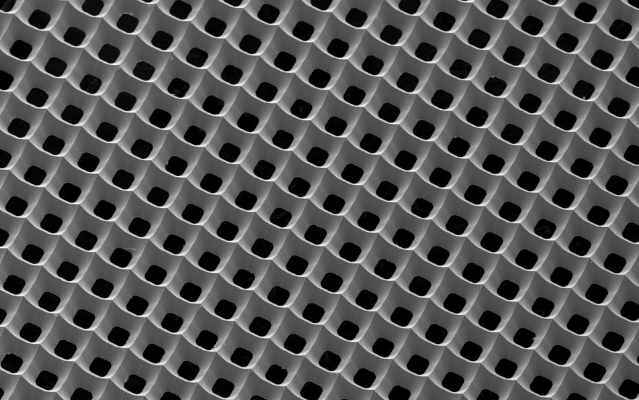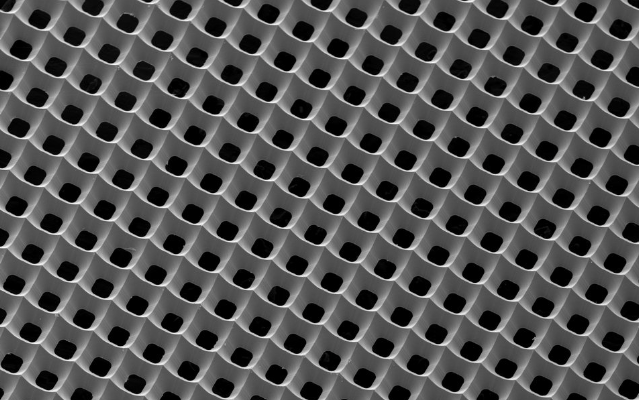Fine Metal Mask Production for OLED Display

In the world of OLED display production, the process of creating fine metal masks is a vital step that often goes unnoticed. These masks, with their micro-sized openings and precise design, play a crucial role in ensuring the high-resolution images that OLED displays are known for.

Micrograph of the Fine Metal Mask (FMM).
The Role of Fine Metal Masks in OLED Display Production
Fine metal masks play a crucial role in the production of OLED displays. These masks are used in the deposition process of organic materials onto the display substrate. They act as a stencil, allowing only the desired materials to pass through and form the pixels on the display. The precise design and manufacturing of these masks determine the quality and performance of the OLED display.
Using fine metal masks ensures the accurate placement and alignment of the organic materials, resulting in high-resolution and sharp images. These masks are designed to have micro-sized openings, allowing for the precise deposition of red, green, and blue organic materials needed to create vibrant and colorful displays. Without fine metal masks, it would be challenging to achieve the pixel density and color accuracy that OLED displays are known for.
Manufacturing Process of Fine Metal Masks
The manufacturing process of fine metal masks for OLED displays involves several steps. First, a thin metal sheet, typically made of stainless steel or nickel, is chosen as the base material. The sheet is then cleaned and prepared to ensure a smooth and pristine surface. Next, a layer of photoresist is applied to the metal sheet, which will act as a protective coating during the subsequent processes.
Once the photoresist is applied, a photolithography process is used to transfer the desired pattern onto the metal sheet. This process involves exposing the photoresist to UV light through a mask with the desired pattern. The exposed areas of the photoresist are then developed and removed, leaving behind the pattern on the metal sheet. This pattern defines the openings through which the organic materials will be deposited.
After the photolithography process, the metal sheet undergoes an electroforming process. This process involves immersing the metal sheet in an electrolyte solution and applying an electric current. The current causes metal ions to deposit onto the exposed areas of the metal sheet, gradually building up the desired thickness. This electroforming process ensures the precise dimensions and smoothness of the fine metal mask.
Once the electroforming process is complete, the metal sheet is carefully removed from the mask. The mask undergoes a series of cleaning and quality control procedures to ensure its performance and reliability. Finally, the mask is ready to be used in the OLED display production process.
Quality Control Measures for Fine Metal Masks
To ensure the quality and reliability of fine metal masks for OLED displays, strict quality control measures are implemented throughout the production process. These measures include rigorous inspections and testing at various stages of manufacturing.
During the initial material selection and preparation phase, the metal sheets are inspected for any defects or impurities. Any flawed sheets are discarded to ensure only high-quality materials are used. The photoresist coating is also inspected for uniformity and proper adhesion to the metal surface.
After the photolithography process, the patterned metal sheets undergo thorough visual inspections to ensure the accuracy and integrity of the pattern. Any deviations or imperfections are identified and corrected. The electroforming process is closely monitored to ensure the deposition of metal ions is consistent and uniform.
Once the fine metal masks are produced, they undergo comprehensive testing to verify their performance. This includes tests for dimensional accuracy, durability, and resistance to wear and tear. The masks are also tested for their compatibility with the OLED display production process, ensuring they can withstand the deposition of organic materials without any issues.
By implementing these quality control measures, manufacturers can ensure that only high-quality fine metal masks are used in the production of OLED displays, resulting in displays with superior performance and longevity.
Future Trends in Fine Metal Mask Technology
As technology continues to advance, the field of fine metal mask production for OLED displays is also evolving. Several future trends and developments can be expected in this area.
One of the key trends is the miniaturization of fine metal masks. As display resolutions increase and pixel sizes decrease, the openings in the masks need to become smaller and more precise. Advanced manufacturing techniques, such as nanoimprint lithography and electron beam lithography, are being explored to achieve this level of miniaturization.
Another trend is the development of alternative materials for fine metal masks. While stainless steel and nickel are commonly used, other materials with improved properties, such as enhanced durability or higher thermal conductivity, are being researched. These alternative materials could further enhance the performance and reliability of fine metal masks.
Furthermore, advancements in mask design software and simulation tools are expected. These tools can aid in the optimization of mask designs and improve the accuracy of the deposition process. Additionally, the integration of artificial intelligence and machine learning algorithms can help automate and streamline the mask production process, reducing costs and improving efficiency.
Overall, the future of fine metal mask technology for OLED displays holds great promise. With ongoing research and development efforts, we can expect to see even more precise, durable, and efficient masks, contributing to the advancement of OLED display technology.





